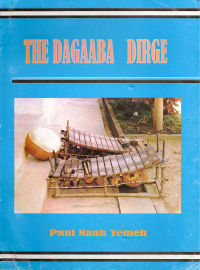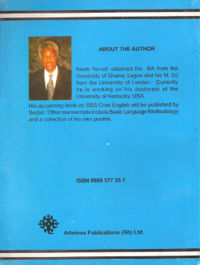The Dagaaba Dirge
Primarily my intention in this book is to record and transcribe the Dagaaba dirge as accurately as possible. The Dagaaba dirge can be said to be the culminating point of Dagaaba culture. It embraces their philosophy, drama, music, history, education and socialization process. Indeed, the funeral scene is a re-enactment of the totality of the peoples' way of life-a-mirror on the Dagaaba society. In short the Dagaaba dirge is their culture preserved in its cyst form.
However, modern formal education and subsequent technological developments, money economy, and rural-urban migration as well as the upsurge of forces which are hostile to Dagaaba traditions, particularly, Islam and other religious sects, seem to threaten the existence of the Dagaaba dirge. hence the need to put it on record.
The book is divided into four parts. Part one is the introduction, and is aimed at providing a general background to the translated dirges within the framework of the Dagaaba view. Here, there is an attempt to trace the origins of the Dagaaba dirge, an endeavour which of necessity I had to cast into the general mainstream of the world's oral literary traditions. Also, the social significance of the dirge and its apprenticeship are discussed, followed by an analysis of the characteristics of the Dagaaba language as reflected in the dirges.
In part two, attention is concentrated on th special features of the Dagaaba dirge. Its performance, structure and themes are dealt with. Part Two ends with a note on classification of the dirge, a description of the musical instruments, summary and suggestions for further research.
Part Three is made up of the original dirges in Dagaare and Part Four, which is mainly the translated dirge, opens with a discussion of the problems encounted in the research.
Dr. Paul Naah Yemeh 00233244058943/ 002330287284522
Table of Contents
- PAGE
Dedication...................................................iii
Acknowledgements......................................iv
Table of Contents.........................................v
PART ONE
Introduction............................................................1
1.1 General Background..........................................2
1.2 Way of Life.......................................................5
1.3 The Dagaaba Cosmology...................................6
1.4 The Origins of Dagaaba Dirge.............................8
1.5 The Social Significance of the Dagaaba Dirge......10
1.6 The Apprenticeship...........................................12
1.7 Sources of the Dirges.......................................14
PART TWO
SPECIAL FEATURES OF THE DAGAABA DIRGE
2.1 Performance...................................................17
2.2 Structure........................................................19
2.3 Themes..........................................................22
2.4 Classification .................................................25
2.5 Musical Instruments........................................27
PART THREE
THE ORIGINAL DIRGES IN DAGAABA
3.1 Naa Kuori (Dirge for a chief)............................30
3.2 Dao Kuori (Dirge for a Man).............................33
3.3 Poga Kuori (Dirge for a Woman)......................42
3.4 Bibile Kuori (Dirge for a Child)..........................46
3.5 Zombie Lanne (Insult Dirges)...........................49
PART FOUR
THE TRANSLATED DIRGES
4.1 Problems and Solutions........................................51
4.2 The Dirge on the Occasion of a Chief's Funeral.......52
4.3 The Dirge on the Occasion of a Man's Funeral........54
4.4 the Dirge on the Occasion of a Woman's Funeral....63
4.5 the Dirge on the Occasion of a Child's Funeral........66
4.6 Insult Dirges........................................................68
Appendix I The Questionnaire Use in Fieldwork............70
Appendix II People Interviewed....................................71
Notes.......................................................................72

